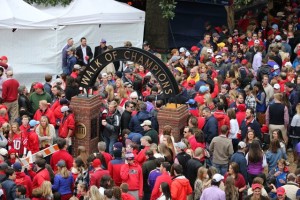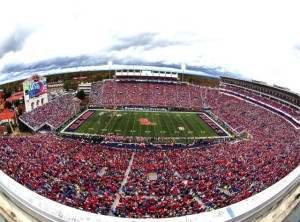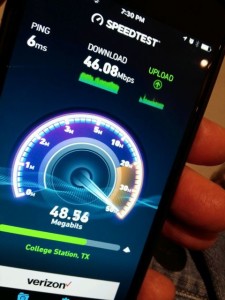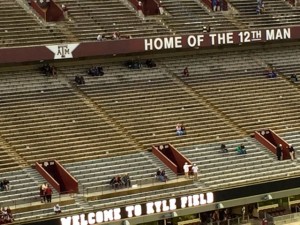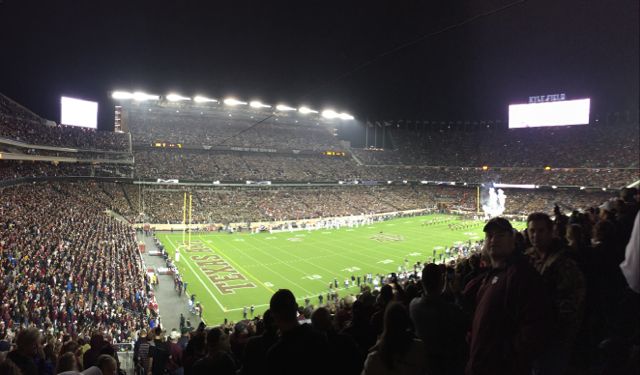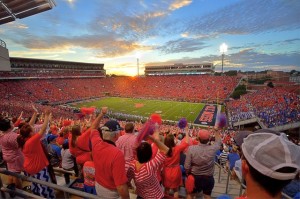
Game day at Vaught-Hemingway Stadium. All photos: Joshua McCoy/Ole Miss Athletics (click on any photo for a larger image)
And now, you can add fan-facing Wi-Fi in Vaught-Hemingway Stadium to the mix.
While some might fret that bringing high-speed wireless communications to football stadiums takes away from the live experience, the reality of life in today’s connected society is that people expect their mobile devices to work wherever they roam, even if it’s to a place where 60,580 of their closest friends also congregate, like they do at Vaught-Hemingway on Saturdays in the fall.
Add in the desire these days for football fans to share their live experiences with friends and others over social network sites, and you can see why the demand for mobile bandwidth is now as much a part of college football as marching bands and tailgating parties.
Through a partnership with wireless service provider C Spire, and using Wi-Fi gear from Xirrus, Ole Miss brought fan-facing Wi-Fi to Vaught-Hemingway stadium in 2014, and just finished up its second season of service. According to Michael Thompson, senior associate athletic director for communications and marketing at Ole Miss, the need for better stadium connectivity surfaced after the school started conducting fan experience research about 5 years ago.
“Connectivity was just one component” of the research, said Thompson, alongside questions about many different elements of the game-day experience including parking, ticket-taker friendliness, concession prices and time spent waiting in lines. And then there were questions about using mobile devices for emails or voice calls.
“We saw [from the surveys] that we had some issues in meeting fan needs, especially in those two areas [voice calls and email],” Thompson said. And while Vaught-Hemingway did have a neutral-host Crown Castle DAS installed several years ago, Thompson said the carrier investment in the deployment was uneven.Bringing in ‘state of the art’ Wi-Fi
Editor’s note: This story is part of our most recent STADIUM TECH REPORT, the COLLEGE FOOTBALL ISSUE. The 40+ page report, which includes profiles of stadium deployments at Texas A&M, Kansas State, Ole Miss and Oklahoma, is available for FREE DOWNLOAD from our site. Get your copy today!
To bolster connectivity in a method free of the constraints of a DAS, Thompson said the school put out an RFP for stadium Wi-Fi, and found “an incredible partner” in C Spire, a leading connectivity provider in the region around the Oxford, Mississippi campus.
Among the challenges in bringing Wi-Fi to Vaught-Hemingway — a stadium whose initial version was built in 1915 — was a lack of overhangs to place Wi-Fi access points, and old construction methods that wouldn’t allow for under-the-seat APs. But using Xirrus gear, C Spire and Ole Miss found a deployment method that worked — putting a lot of APs underneath the stands, shooting upwards through the concrete.
With 820 Wi-Fi APs inside the stadium, Thompson said the “Rebel Wi-Fi” network is “absolutely a state of the art system,” supporting “tens of thousands” of fans concurrently on the network during football games. Using analytics, Thompson said “it’s interesting to watch [online] behaviors, and to see what people are doing when there are big spikes [in traffic].” Not surprisingly, Thompson said that one recurring spike happens right after each opening kickoff, “when a lot of photos get shared.”
A small fee for non-C Spire customers
Promotion of the Wi-Fi network, Thompson said, starts with C Spire itself, since the carrier is the service provider “for a fairly large percentage of our fans.” C Spire customers can use the Wi-Fi network for free, Thompson said, and can have their devices autoconnect whenever they come to a game.
Non-C Spire customers, however, must pay a small fee for use of the Wi-Fi, which can either be added to the cost of a season ticket (the charge is $25 for a full-season Wi-Fi pass) or can buy a “day pass” for a $4.99 fee per game. Thompson said the network has no restrictions or blocking, and has seen fans “watching another game live” while at Vaught-Hemingway.While it might take time to become a hallowed tradition, it’s a good bet that over time the Ole Miss fans will become as used to taking and sharing videos, photos and texts as they do rooting together and congregating along the “walk of champions” before games. It might not date back to 1915, but it’s an amenity that many mobile-device owners will cherish once they find out it’s there.
“There’s still a lot of people who just accept that it’s going to be hard to connect [at a stadium] because they were trained to think that for so long,” Thompson said. “Connectivity just dropped off their radar.”
